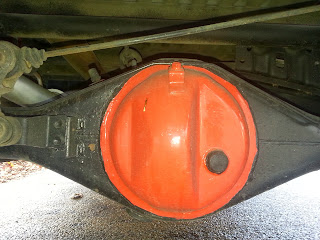This is a rough Idea of my planned 'center console'. There currently isn't one at all, and frankly it's a lot of no space there at all and a bit ugly.
The rough idea of the layout will be something like the image below.
I'll be using a 1/4" plywood, and small 1" sqr hardwood stock to keep the panels secure. They'll be screwed in place and woodglued as well. Once the main construction of the console is completed, and all the holes are cut (at least more of them). I'll be using an old-school black quilted-leather material for the drivers and passengers sides of the console. The center 'dial/shift' (top) panel will be covered with fake ostrich black leather. Should be really cool looking when it's done. And really original with a nod to the 60s with the quilted leather (found on ebay for a few bucks!).
Also note the battery, fuel-pump, ignition, fan switches at the top of the console. These will replace the keyed-ignition-switch. There will be a 'hidden master switch' that will enable/disable these switches.
Ignore the price noted on the drawing. I have learned to grossly over-estimate planned projects for those 'just in case' times. LOL 40 years of doing various projects has taught me to always over estimate costs, because things NEVER seem to come in on a tight budget. Most of the costs related to this are for the gauges themselves. There are thousands of gauge manufacturers, and prices range dramatically. I'm still researching the ones I will end up with. 'Autometer' makes some nice, reasonably priced ones, as well as PLX. I like the fancy PLX sensors, but I'm not really convinced they're what I really want. In the end, I don't care so much about 'fancy', but I do care about 100% function.
UPDATE:
- Ordered the quilted leather and fake ostrich leather for the console on 11/29. Should be here around Dec 2nd.
- Ordered (UPDATE PLX still hasn't shipped these 12/4 ~ Loosers! They arrived 12/6 safe and sound though):
- PLX Devices DM-6 digital Gause with Wideband AFR
- PLX Devices Vacuum/Boost Sensor Module
- PLX Devices Exhaust Gas Tempuratue Sensor Module
- NOTE: are some examples of the DM-6 in operation
UPDATE 2:
The PLX digital gauge, and 3 sensors arrived today 12/6. Unfortunately it's now a high of about 16F outside and 13" of fresh snow! Guess I'll wait until things warm up to at least the freezing point now!
UPDATE 3
UPDATE 3











